Family Court Statistics Quarterly: July to September 2021
Published 16 December 2021
1. Main Points
| Decrease in the number of cases started in the Family Courts | 63,084 new cases started in Family courts in July to September 2021, down 11% on the same quarter in 2020. This was due to decreases in all case types: matrimonial (15%), public law (14%), adoption (12%), private law (10%), domestic violence (8%) and financial remedy (5%) cases. |
| On average, care proceedings took longer with fewer disposals within 26 weeks. | The average time for a care or supervision case to reach first disposal was 45 weeks in July to September 2021 , up 4 weeks from the same quarter in 2020. 24% of cases were disposed of within 26 weeks - down 5 percentage points compared to the same period in 2020 . |
| Decrease in the average time for divorce proceedings | The mean average time from petition to decree nisi was 26 weeks, and decree absolute was 55 weeks - down 3 weeks and up 4 weeks respectively when compared to the equivalent quarter in 2020. The median time to decree nisi and decree absolute was 14 and 32 weeks respectively. |
| Decrease in the number of divorce petitions, while decree absolutes increase. | There were 25,587 divorce petitions filed in July to September 2021, down 15% on the equivalent quarter in 2020. There were 27,412 decree absolutes granted in July to September 2021, an increase of 16% from the same period last year. |
| Decrease in both domestic violence remedy applications and orders made. | The number of domestic violence remedy applications decreased by 8% compared to the equivalent quarter in 2020, while the number of orders made decreased by 10% over the same period. |
| Adoption applications decrease while the number of orders increase | In July to September 2021 there were 954 adoption applications, down 14% on the equivalent quarter in 2020. Whereas, the number of adoption orders issued increased by 7% to 1,104. |
| Decrease in deprivation of liberty applications and increase in orders made. | There were 1,602 applications relating to deprivation of liberty in July to September 2021, down 8% on the equivalent quarter in 2020. Orders increased by 18% in the latest quarter compared to the same period last year. |
| Increase in the proportion of applications for probate grants and probate grants issued made digitally | In July to September 2021, there were 52,750 applications for probate grants. 58,642 probate grants were issued in the same period. 79% of these applications and 82% of these grants issued were made digitally, compared to 45% and 46% respectively in the same quarter in 2020. |
This publication presents statistics on activity in the family courts of England and Wales and provides figures for the latest quarter (July to September 2021). For further information and technical details please refer to the accompanying Guide to Family Court Statistics.
For feedback related to the content of this publication, please let us know at familycourt.statistics@justice.gov.uk
2. Statistician’s comment
Volumes of new cases starting across all Family Justice areas have decreased this quarter, possibly stabilising following the recovery from the impact of Covid-19 in the end of 2020 and early 2021. As seen last quarter, the latest figures are more in line with longer term trends seen pre-Covid 19. Closed cases have increased in several areas, in particular for matrimonial-related cases, with the courts working through backlogs as Covid-19 restrictions have eased. Whilst the number of new cases starting has decreased, there continues to be an impact on timeliness measures. In particular, care and supervision proceedings have increased further to levels last seen at the end of 2012 and Children Act cases more widely have also seen increases in the time to a first definitive disposal. There has also been a recent increase in the time for probate grants to be issued, following a focus from HMCTS to work through longer cases that had been stopped. As timeliness averages are measured from the first application in a case, data for the next few quarters are likely to continue to include some cases issued before or during the early stages of the pandemic. Measures implemented following the pandemic, such as the opening of Nightingale courts and the increase in hearings by remote means, will have benefitted later cases and as such should begin to impact on timeliness measures in the next few quarters.
3. Overview of the Family Justice System
Decrease in the number of cases started in Family Courts and increase in the number of cases disposed
In July to September 2021, 63,084 new cases started in family courts, down 11% on the equivalent quarter in 2020. This was due to decreases in all case types: matrimonial (15%), public law (14%), adoption (12%), private law (10%), domestic violence (8%) and financial remedy (5%) cases.
There were 61,249 case disposals in July to September 2021, up 9% on the equivalent quarter of 2020. This was due to increases in financial remedy (19%), matrimonial (16%) and domestic violence (5%) cases. However, there was a decrease in adoption (7%), public law (7%) and private law (2%) case disposals. (Table 1)
Figure 1: Cases started and disposed, by case type, January to March 2011 to July to September 2021 (Source: Table 1)
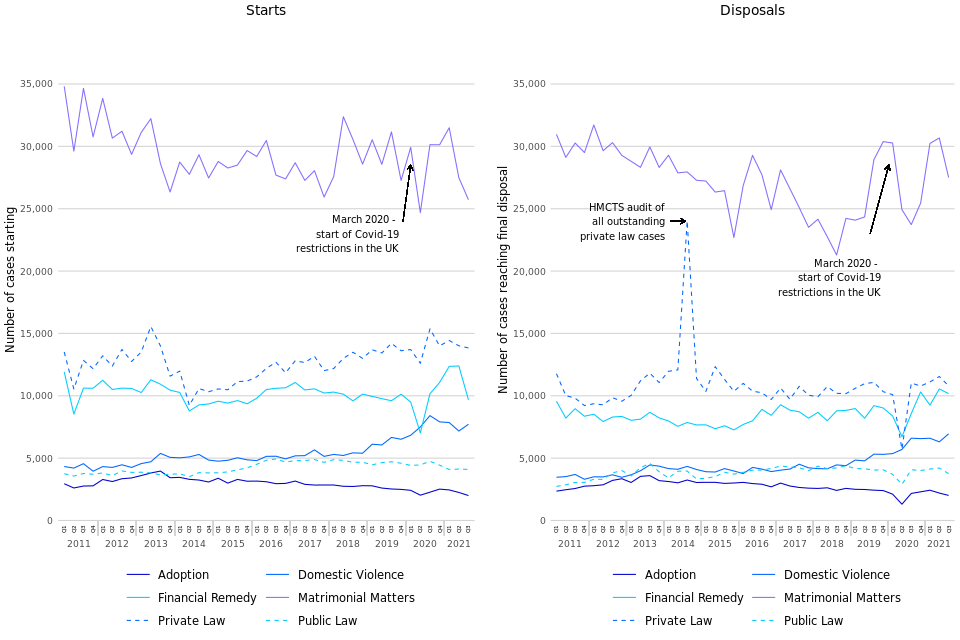
In July to September 2021, 41% of new cases within family courts related to matrimonial matters, similar to the equivalent quarter of 2020 (42%).
Timeliness by Case Type
Average time to first disposal varies by case type – public law cases generally take the longest and in 2011, on average, they took nearly a year to reach a first disposal (49 weeks). From 2011, the average fell steadily and by 2016, almost halved to reach 26 weeks.
However, it increased in 2017 to 27 weeks. For July to September 2021 the average was 44 weeks, up from 39 weeks during the same period in 2020 (Table 10).
The average time for divorce and annulment cases to reach first disposal was down 3 weeks compared to the equivalent quarter in 2020. Private law cases took longer, with the average time to first disposal in July to September 2021 taking 26 weeks, up 7 weeks compared to the same period in 2020.
Public and private law cases – number of parties, and High Court cases
The vast majority of private law cases involve one applicant and one respondent only (Table 6). However, for public law cases whilst nearly all cases have only one applicant, 73% involve two or more respondents.
A very small proportion of public (3%) and private (1%) law cases started were indicated as being a High Court case during July to September 2021, consistent with the long-term trend (Table 7).
HMCTS monthly management information
The statistics in this publication focus on the period between July to September 2021; however, monthly management information (MI) has been published by HMCTS that covers up to October 2021. https://www.gov.uk/government/statistical-data-sets/hmcts-management-information-october-2021. This MI is subject to the data quality issues associated with extracting data from large live administrative case management systems. Late reporting of cases and regular updating of case details, which can lead to the figures being updated to manage the case - more recent figures may therefore be subject to larger revisions and should be treated with greater care and considered provisional.
4. Children Act - Public Law
Decrease in the number of public law case starts and cases disposed
There were 4,092 public law cases starting in July to September 2021, down 14% compared to the equivalent quarter in 2020. Cases disposed were down 7% to 3,763 (Table 2).
Average time for care proceedings continues upward trend
The average time for a care and supervision case to reach first disposal was 45 weeks in July to September 2021, up 4 weeks from the same quarter in 2020 and the highest average since 2012. 24% of these care proceedings were disposed of within the 26-week limit introduced in the Children and Families Act 2014, down 5 percentage points from the same period last year (Table 8).[footnote 1]
There were 6,744 individual children involved in new public law applications in July to September 2021, down 15% on the same quarter in the previous year, while the number of applications made decreased by 14%.The number of public law disposal events decreased by 5% over the same period.
Figure 2 shows the most common types of public law orders applied for and made in July to September 2021, illustrating the different pattern between the types of orders applied for and the orders that are given, i.e. an application for one type can result in an order of a different type being made.
Figure 2: Public law applications and orders made, showing the number of children involved in each order type, July to September 2021 (Source: Tables 3-4)
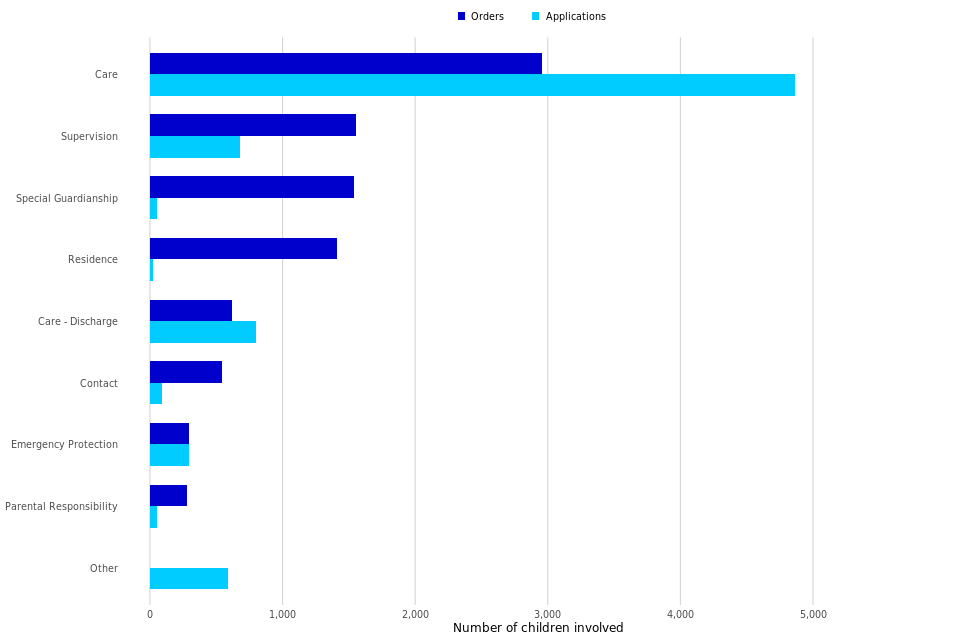
5. Children Act - Private Law
Decrease in the number of private law case starts and cases disposed
The number of private law cases[footnote 2] started decreased by 10% (to 13,836) in July to September 2021 compared to the equivalent quarter in 2020. The number of applications made decreased by 10% over the same period.
The number of private law cases disposed of during July to September 2021 was down 2% on the equivalent quarter in 2020, with the number of court disposal events up by 4% (Table 2).
There were 14,263 new private law applications made in July to September 2021, down 10% on the equivalent quarter in 2020, with 21,510 individual children involved in these applications.
The number of private law court disposal events in July to September 2021 was 19,059, up 4% on the equivalent quarter in 2020.
Timeliness of Private law cases
In July to September 2021, it took on average 42 weeks for private law cases to reach a final order, i.e. case closure, up 9 weeks from the same period in 2020 – reaching record levels in this published time series. This continues the upward trend seen since the middle of 2016, where the number of new cases overtook the number of disposals (Table 9).
Figure 3: Private law timeliness from case start date to final order in the family court, January to March 2011 to July to September 2021 (Source: Table 9)

6. Legal Representation
Cases with legal representation take longer on average
In general, cases where either both parties or the respondent only had legal representation took longer to be disposed of than those cases where only the applicant was represented or where both parties were without legal representation (Table 10).
Legal representation in private law cases
The removal of legal aid for many private law cases in April 2013 resulted in a change in the pattern of legal representation over time[footnote 3],[footnote 4]. In July to September 2021, the proportion of disposals where neither the applicant nor respondent had legal representation was 37%, increasing by 23 percentage points since January to March 2013, and up 1 percentage point from July to September 2020.
Correspondingly, the proportion of cases where both parties had legal representation went from 41% in January to March 2013 to 19% in July to September 2021, down 4 percentage points compared to the same period in 2020 (Figure 4).
Figure 4: Proportion of private law disposals by type of legal representation of the parties, January to March 2012 to July to September 2021 (Source: Table 10)
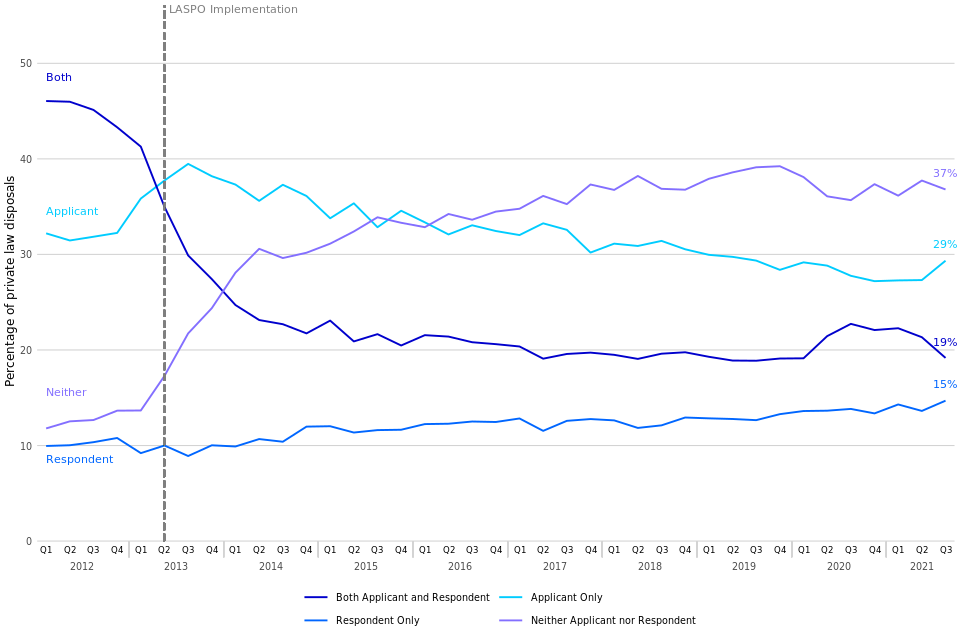
The change seen in the pattern of legal representation is also demonstrated in private law cases with at least one hearing where the proportion of parties with legal representation stood at 59% in 2012 compared to 31% in July to September 2021.
The proportion of parties with legal representation in cases with at least one hearing varies by case type and range from around 74% for public law cases to 2% for adoption cases, with figures subject to change as new cases progress (Table 11).
7. Divorce
Decrease in the number of divorce petitions whilst number of absolutes increases
Divorce petitions were down by 15% in July to September 2021 compared to the same period in the previous year. Decree absolutes granted were up by 16% in July to September 2021 compared to the same period in 2020.
Average time for proceedings decreased
Average time from petition to decree nisi decreased to 26 weeks in July to September 2021, from 29 weeks in the same quarter of 2020 (Table 12).
There were 25,587 divorce petitions made during July to September 2021, down 15% from the same quarter in 2020. There were 27,412 decree absolutes granted in July to September 2021, up by 16% compared to the same quarter in 2020 (Table 12).
Timeliness of divorce cases
For those granted decree nisi in July to September 2021, the mean average time from the date of petition was 26 weeks, down 3 weeks from the same period in 2020. The mean average time from petition to decree absolute was 55 weeks, up 4 weeks from the equivalent quarter in 2020.
The mean timeliness figures can be inflated when historical cases reach decree nisi or decree absolute. These historical cases have less effect on the median timeliness, which may act as a better indicator for the length of current divorce proceedings. In July to September 2021, the median time to decree nisi was 14 weeks and 32 weeks to decree absolute.
Digital divorce cases
For digital divorce cases (i.e. those dealt with the Courts and Tribunals Service Centres that are digital at all stages), there were 20,397 petitions made during July to September 2021 (80% of the total, up from 64% in the same period of 2020). The average time to decree nisi for July to September 2021 was 14 weeks, and 24 weeks from petition to decree absolute.
Figure 5: Divorce petitions made between Q3 2019 to Q3 2021, by case type (Source: Table 12)
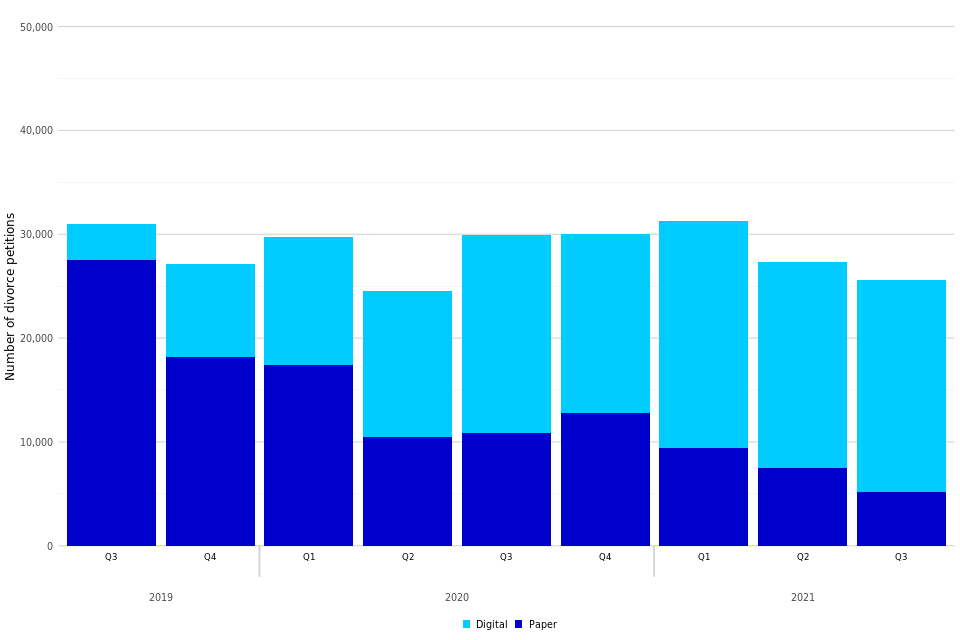
29% of divorce petitions made between Q1 2011 to Q3 2021 reached decree nisi in the first quarter after the petition was made, with a further 37% reaching this stage within the second quarter. Over half the petitions reached a decree absolute within three quarters after petition (2% in the first quarter, 31% within 1 to 2 quarters and 20% within 2 to 3 quarters) (Table 14).
8. Financial Remedy
Decrease seen in financial remedy applications, increase in disposal events
In July to September 2021, the number of financial remedy applications was down 7% and the number of disposal events was up 11% compared to the same period in 2020 (Table 15).
There were 10,015 financial remedy applications made in July to September 2021, down 7% from the same period in 2020, while there were 11,788 financial remedy disposals events, up 11%. During this period, 72% of applications were uncontested and 28% were contested.
Figure 6: Applications for financial remedy orders, January to March 2009 to July to September 2021 (Source: Table 15)

9. Domestic Violence Remedy Orders
Decrease in both the number of domestic violence remedy applications and orders made
In July to September 2021, there was an 8% decrease in applications compared to the equivalent quarter in 2020. The number of orders made decreased by 10% over the same period (Table 16).
In July to September 2021, there were 7,905 domestic violence remedy applications, down by 8% on the same quarter in 2020, requesting a total of 9,077 orders (multiple orders can be applied for in a single application). Most of the orders applied for were non-molestation orders (84%) compared to occupation orders (16%); these proportions have remained relatively consistent in recent years. Applications for non-molestation and occupation orders in July to September 2021 were both down, by 7% and 17% respectively, compared to the same period in 2020.
There were 9,532 domestic violence orders made in July to September 2021, down 10% from the same period last year. 94% were non-molestation orders and 6% were occupation orders, with non-molestation orders down by 10% and occupation orders down by 16% compared to the equivalent quarter in 2020.
Figure 7: Domestic violence remedy orders applied for, January to March 2009 to July to September 2021 (Source: Table 16)
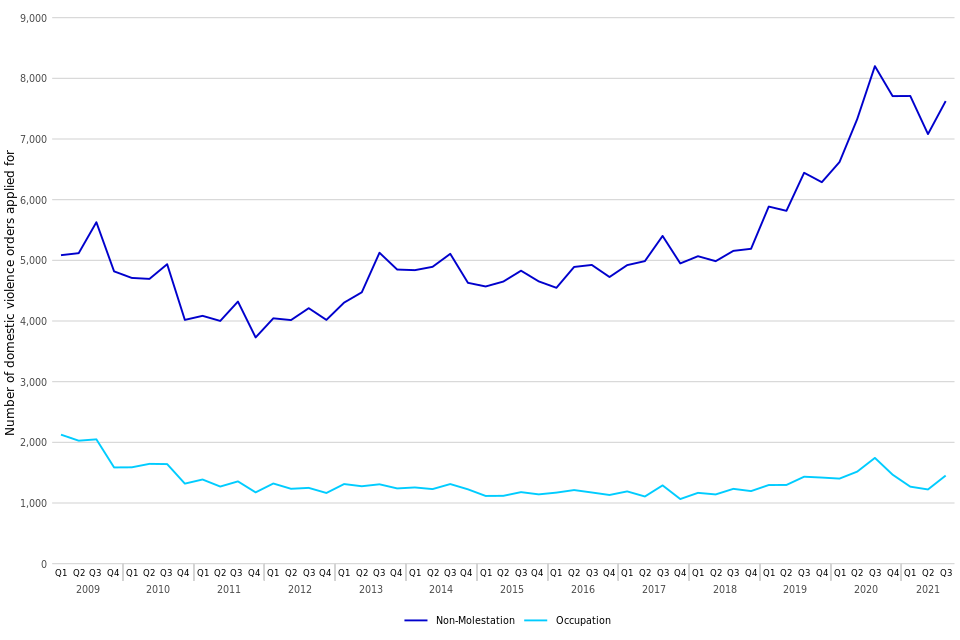
10. Forced Marriage Protection Orders and Female Genital Mutilation Protection Orders
Long term upward trend in the number of forced marriage protection orders and female genital mutilation orders, with a more recent decline in female genital mutilation protection orders (Table 17 and 18).
The number of applications and orders made for forced marriage protection orders (FMPOs) is very small. Consequently, numbers fluctuate each quarter but overall there was a long term upward trend from their introduction in November 2008 until the end of 2019.
However, this seems to have reversed during 2020. In July to September 2021, there were 38 applications, of which 66% of applications were for people aged 17 and under. Over the same period, there were 68 orders made, up 1% since the same period from the previous year.
The increase in the number of orders does not necessarily represent an increase in the prevalence of forced marriage, but potentially it relates to a greater awareness of forced marriage being a crime and the support available. The government have held events during 2019 with relevant groups (local authorities, police, charities etc.), designed specifically to raise awareness of FMPOs and how they can be used to protect those at risk. Historically the numbers of orders made outweigh the number of applications. Often there are multiple orders granted per case, where one application covers more than one person, and an order is granted for each person covered in the application. Extensions and increased provision of previous orders can also be granted as new orders, without the need for a new application to be submitted.
Figure 8: Applications and orders made for Forced Marriage Protection Orders, January to March 2009 to July to September 2021 (Source: Table 17)

As with FMPOs, the number of applications and orders made for female genital mutilation protection orders (FGMPOs) is very small, with only 9 applications and 13 orders made respectively in July to September 2021 (Table 18). In total, there have been 510 applications and 730 orders made up to end of September 2021, since their introduction in July 2015.
11. Adoptions
Decrease in the number of adoption applications and an increase in orders made
During July to September 2021, there were 954 adoption applications made, down 14% from the equivalent quarter in 2020. Over the same period, the number of adoption orders issued increased by 7% to 1,104 (Tables 19 and 20).
There were 2,005 applications under the Adoption and Children Act 2002, including placement orders during July to September 2021, down 12% on the same quarter in the previous year. Total disposals decreased by 8% to 2,029 over the same period.
The chart below shows the trend of adoption orders by the type of adopter. This shows that during July to September 2021, 56% of all adoption orders were issued to mixed-sex couples, 21% to sole applicants, 16% to same-sex couples and 7% to step-parents.
Figure 9: Adoption orders issued, by adopter, January to March 2011 to July to September 2021 (Source: Table 20)
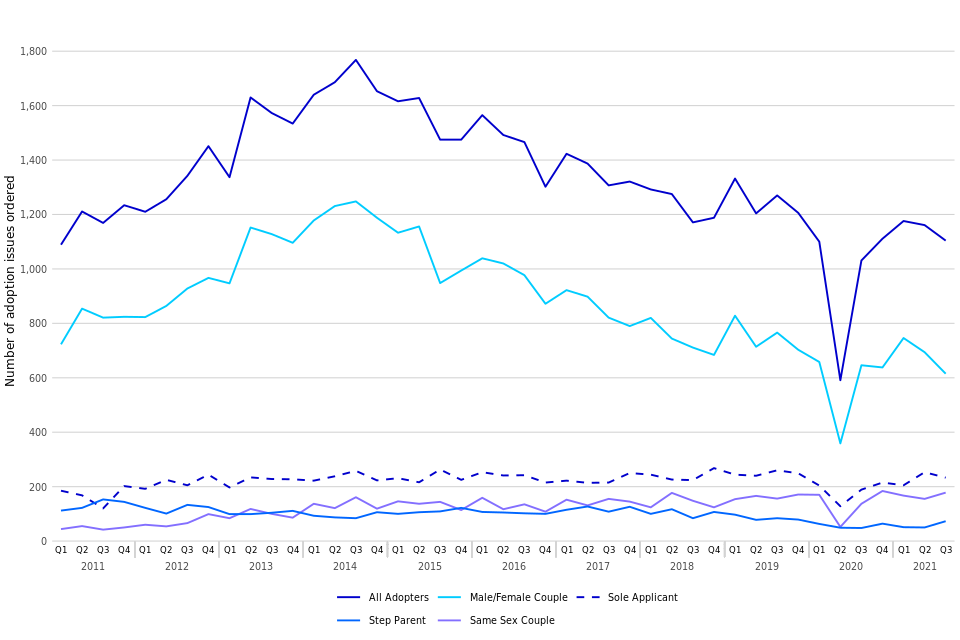
12. Mental Capacity Act - Court of Protection
Decrease in applications with an increase in orders made in relation to deprivation of liberty
There were 1,602 applications relating to deprivation of liberty made in the most recent quarter, which is a decrease of 8% on the number made in the same quarter in 2020. However, there was an increase by 18% in the orders made for deprivation of liberty over the same period from 840 to 988.
An increase in applications whilst orders decrease under the Mental Capacity Act 2005 (MCA)
There were 9,788 applications made in July to September 2021, up by 10% - the highest quarterly volume for applications since the start of the series. During the same period there were 12,355 orders made, down by 8%.
Figure 10: Deprivation of Liberty applications and orders, January to March 2008 to July to September 2021 (Source: Table 22)
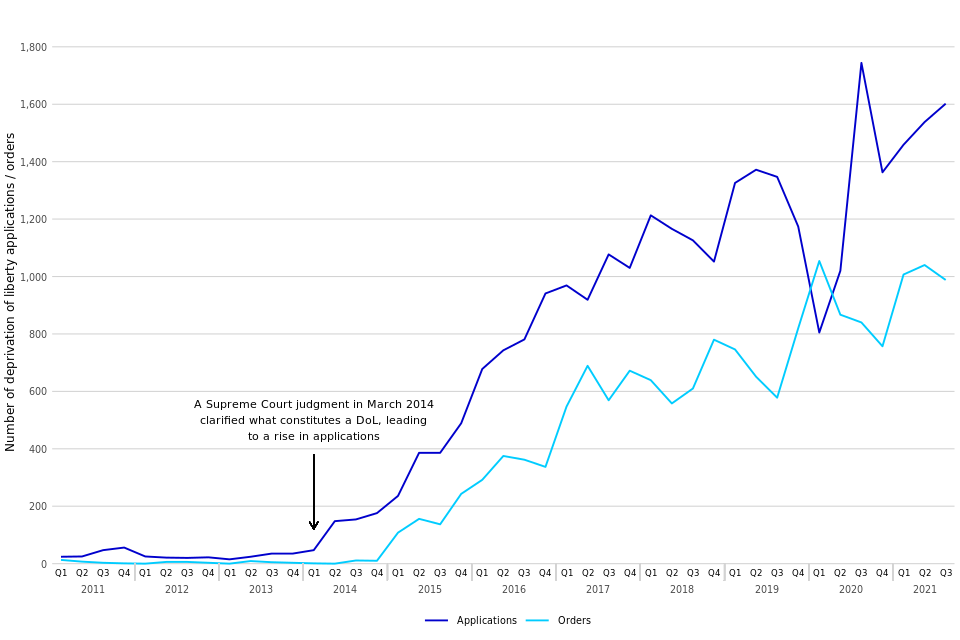
In July to September 2021, there were 9,788 applications made under the Mental Capacity Act 2005 (MCA), up by 10% on the equivalent quarter in 2020 (8,937 applications and the highest level in our published series). Of those, 42% related to applications for appointment of a property and affairs deputy (Table 21).
In comparison, there were 12,355 orders made under the Mental Capacity Act 2005 (MCA), down by 8% on the same quarter in 2020. Of those, 43% related to applications by an existing deputy or registered attorney (Table 22).
13. Mental Capacity Act - Office of the Public Guardian
Continuing increasing trend in Lasting Powers of Attorney (LPAs)
In July to September 2021, there were 169,596 LPAs registered, up 4% compared to the equivalent quarter in 2020 (Table 23).
In total there were 171,418 Powers of Attorney (POAs) registered in July to September 2021, up 4% from the same quarter in 2020 (Table 23). Lasting Power of Attorney (LPAs) made up 99% of POAs registered in July to September 2021, with Enduring Powers of Attorney (EPAs) making up the other 1%. There were 1,822 EPAs registered in July to September 2021, up 13% on the equivalent quarter in 2020.
The sharp increase in LPAs seen during 2015 and 2016 was largely due to increased publicity and the new online forms introduced in July 2015 making it simpler and faster to apply.
Figure 11: Powers of Attorney registered, January to March 2008 to July to September 2021 (Source: Table 23)
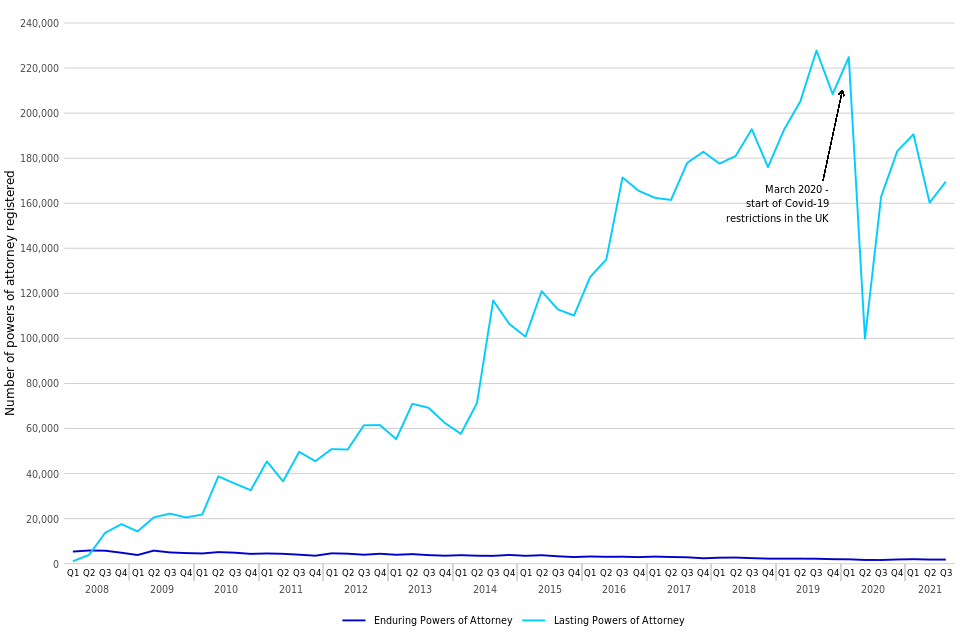
57% of POAs registered were from female donors in July to September 2021 and 41% were from male donors. Altogether 51% were over 75 years old.
14. Probate Service
Increase in both the proportion of digital applications for probate grants and probate grants issued digitally
In July to September 2021, there were 52,750 applications for probate grants. 58,642 probate grants were issued in the same period. 79% of these applications and 82% of these grants issued were made digitally, compared to 45% and 46% respectively in the same quarter in 2020 (Table 24).
Probate grants issued more quickly than other grants of representation
Probate grants took approximately 9 weeks to be issued after the application was submitted during July to September 2021. Letters of administration with a will and without a will took around 12 and 10 weeks respectively (Table 25).
There were 66,019 applications made for grants of representation in July to September 2021. 52,750 (80%) of these were for probate grants, of which 79% were made digitally (Table 24).
Probate grants also make up the majority (82%) of all grants issued. In July to September 2021, 63% of the grants issued were applied for by legal professionals and 37% were personal applications (Table 24). For the 58,642 probate grants issued in the same period, 82% were issued digitally.
Timeliness of probate grants
The average time from application submission to grant issue for probate grants was 9 weeks (median average 6 weeks) overall. Averages for letters of administration with a will and without a will were 12 and 10 weeks respectively for July to September 2021 (Table 25).
Timeliness of grants issued can be affected if the case has been ‘stopped’ for any reason (which can occur when there’s a dispute about either who can apply for probate or issues with a will or proposed will, or if an error is identified and a request for further information made). Probate grants that were stopped during July to September 2021 took 15 weeks on average to be issued, compared to 5 weeks for those that were not stopped.
When looking at the time from document receipt (i.e. when payment has been made and the application and all accompanying documents are ready for examination) to grant issue, this is around 2 weeks quicker than the average time from application submission for probate grants.
In the last quarter there has been an increase across all timeliness measures as a result of older stopped cases being processed, which in turn reduced available resources to handle non-stopped cases.
Figure 12: Average (mean) time for grants of representation issued from application submission by the Probate Service, July to September 2019 to July to September 2021 (Source: Table 26)[footnote 5]
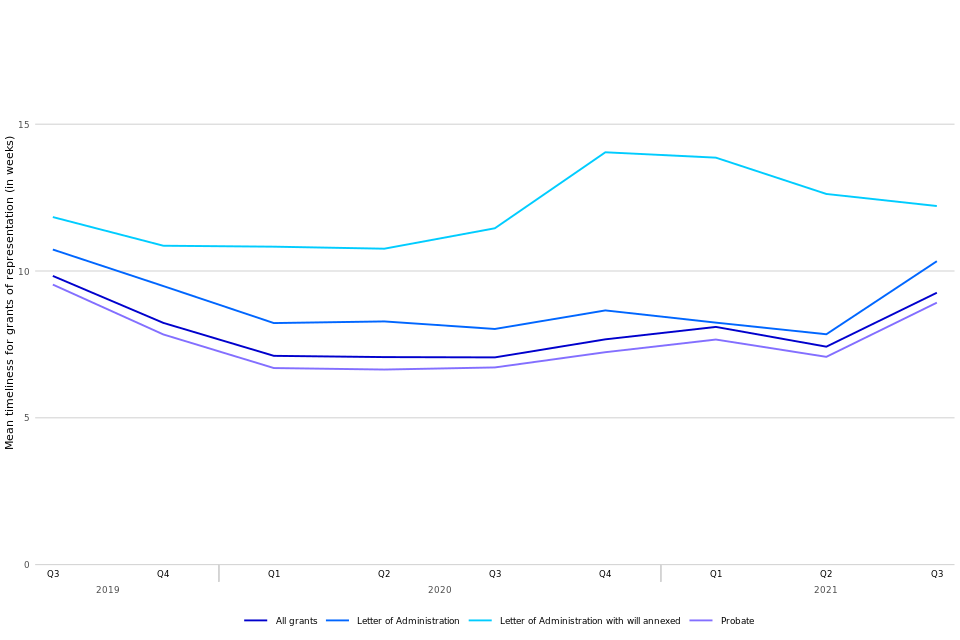
15. Further information
The data presented in this publication are from live administrative databases. Therefore, previously published data is liable to be updated in the latest bulletin, following any further data cleaning or the incorporation of additional cases not available in the extracts used to produce previous bulletins.
Accompanying files
As well as this bulletin, the following products are published as part of this release:
-
A technical guide providing further information on how the data is collected and processed, as well as information on the revisions policy and legislation relevant to family court and background on the functioning of the family justice system
-
A set of overview tables and CSV files, covering each section of this bulletin
National Statistics status
National Statistics status means that official statistics meet the highest standards of trustworthiness, quality and public value.
All official statistics should comply with all aspects of the Code of Practice for Official Statistics. They are awarded National Statistics status following an assessment by the Authority’s regulatory arm. The Authority considers whether the statistics meet the highest standards of Code compliance, including the value they add to public decisions and debate.
It is the Ministry of Justice’s responsibility to maintain compliance with the standards expected for National Statistics. If we become concerned about whether these statistics are still meeting the appropriate standards, we will discuss any concerns with the Authority promptly. National Statistics status can be removed at any point when the highest standards are not maintained, and reinstated when standards are restored.
Contact
Press enquiries should be directed to the Ministry of Justice press office:
Tel: 0203 334 3536
Email: newsdesk@justice.gsi.gov.uk
Other enquiries about these statistics should be directed to the Data and Evidence as a Service division of the Ministry of Justice:
Carly Gray, Head of Access to Justice Data and Statistics, using the following email address familycourt.statistics@justice.gov.uk
Next update: 31 March 2022
URL: https://www.gov.uk/government/collections/family-court-statistics-quarterly
© Crown copyright
Produced by the Ministry of Justice
Alternative formats are available on request from ESD@justice.gov.uk
-
See the accompanying technical guide for more information. ↩
-
The Children and Family Court Advisory and Support Service (Cafcass) also publishes (England only) data on the number of private law cases. A comparison of Cafcass and MoJ data and further information can be found in the accompanying guide. ↩
-
Please see the accompanying guide for further details. ↩
-
Removal of Legal Aid was a result of the Legal Aid, Sentencing & Punishment of Offenders Act 2012 (LASPO). ↩
-
Due to quality issues in the transition between data systems, the breakdown by type of grants of representation for Q2 2019 were rounded estimates only, with the average distribution across 2016 to 2018 applied to the known total. These estimates then feed into the total for 2019. ↩
